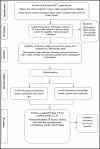INSoles To Ease Pressure (INSTEP) Study: a multicentre, randomised controlled feasibility study to compare the effectiveness of a novel instant optimised insole with a standard insole for people with diabetic neuropathy: a study protocol
- PMID: 30904880
- PMCID: PMC6477388
- DOI: 10.1136/bmjopen-2019-029185
INSoles To Ease Pressure (INSTEP) Study: a multicentre, randomised controlled feasibility study to compare the effectiveness of a novel instant optimised insole with a standard insole for people with diabetic neuropathy: a study protocol
Abstract
Introduction: Foot ulceration is a multifactorial complication of diabetes. Therapeutic insoles and footwear are frequently used to reduce elevated tissue pressures associated with risk of foot ulceration. A novel protocol using in-shoe pressure measurement technology to provide an instant optimised insole and house shoe solution has been developed, with the aim of reducing foot ulceration.
Aim: This study aims to assess the feasibility of conducting a multicentre randomised controlled trial to compare the effectiveness of a novel instant optimised insole with a standard insole for people with diabetic neuropathy.
Methods and analysis: This study is a participant and assessor blinded, randomised, multicentre parallel group feasibility trial with embedded qualitative study. Seventy-six participants will be recruited from three podiatry clinics and randomised to an optimised insole plus usual care (intervention group) or standard insole plus usual care (control group) using a minimisation by randomisation procedure by study centre and previous ulcer status. Assessment visits and data collection will be at baseline, 3 months, 6 months and 12 months. Feasibility and acceptability of the trial procedures will be determined in terms of recruitment and retention rates, data completion rates, intervention adherence and effectiveness of the blinding.Assessment of the appropriateness and performance of outcome measures will inform selection of the primary and secondary outcomes and sample size estimate for the anticipated definitive randomised controlled trial. Clinical outcomes include incidence of plantar foot ulceration and change in peak plantar pressure. Twelve participants (four from each centre) and three treating podiatrists (one from each centre) will be interviewed to explore their experiences of receiving and delivering the intervention.
Ethics and dissemination: The study was approved by the South-West Exeter Research Ethics Committee. Findings will be disseminated through conference presentations, public platforms and academic publications.
Trials registration number: ISRCTN16011830; Pre-results.
Keywords: diabetic foot; primary care; qualitative research.
© Author(s) (or their employer(s)) 2019. Re-use permitted under CC BY. Published by BMJ.
Conflict of interest statement
Competing interests: None declared.
Figures
Similar articles
-
Insoles to ease plantar pressure in people with diabetes and peripheral neuropathy: a feasibility randomised controlled trial with an embedded qualitative study.Pilot Feasibility Stud. 2023 Feb 3;9(1):20. doi: 10.1186/s40814-023-01252-y. Pilot Feasibility Stud. 2023. PMID: 36737812 Free PMC article.
-
Footwear and insole design features that reduce neuropathic plantar forefoot ulcer risk in people with diabetes: a systematic literature review.J Foot Ankle Res. 2020 Jun 4;13(1):30. doi: 10.1186/s13047-020-00400-4. J Foot Ankle Res. 2020. PMID: 32498719 Free PMC article.
-
Shear-reducing insoles to prevent foot ulceration in high-risk diabetic patients.Adv Skin Wound Care. 2012 Nov;25(11):519-24; quiz 525-6. doi: 10.1097/01.ASW.0000422625.17407.93. Adv Skin Wound Care. 2012. PMID: 23080240 Clinical Trial.
-
Footwear and insole design parameters to prevent occurrence and recurrence of neuropathic plantar forefoot ulcers in patients with diabetes: a series of N-of-1 trial study protocol.Trials. 2022 Dec 16;23(1):1017. doi: 10.1186/s13063-022-06968-5. Trials. 2022. PMID: 36527100 Free PMC article.
-
Footwear and insole design features for offloading the diabetic at risk foot-A systematic review and meta-analyses.Endocrinol Diabetes Metab. 2020 Apr 11;4(1):e00132. doi: 10.1002/edm2.132. eCollection 2021 Jan. Endocrinol Diabetes Metab. 2020. PMID: 33532602 Free PMC article.
Cited by
-
Factors associated with changes in plantar pressure of people with peripheral diabetic neuropathy.J Diabetes Metab Disord. 2022 Sep 16;21(2):1577-1589. doi: 10.1007/s40200-022-01104-1. eCollection 2022 Dec. J Diabetes Metab Disord. 2022. PMID: 36404815 Free PMC article.
-
Insoles to ease plantar pressure in people with diabetes and peripheral neuropathy: a feasibility randomised controlled trial with an embedded qualitative study.Pilot Feasibility Stud. 2023 Feb 3;9(1):20. doi: 10.1186/s40814-023-01252-y. Pilot Feasibility Stud. 2023. PMID: 36737812 Free PMC article.
References
-
- Driver VR, Fabbi M, Lavery LA, et al. . The costs of diabetic foot: the economic case for the limb salvage team. J Am Podiatr Med Assoc 2010;100:335–41. - PubMed
-
- Van Dieren S, Beulens JW, van der S, et al. . The global burden of diabetes and its complications: an emerging pandemic. Eur J Cardiovasc Prev Rehabil rehabilitation 2010;17:s3–8. - PubMed
Publication types
MeSH terms
Associated data
Grants and funding
LinkOut - more resources
Full Text Sources
Medical

